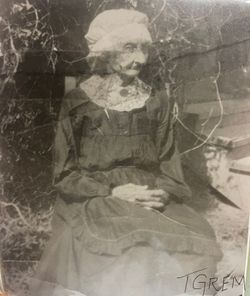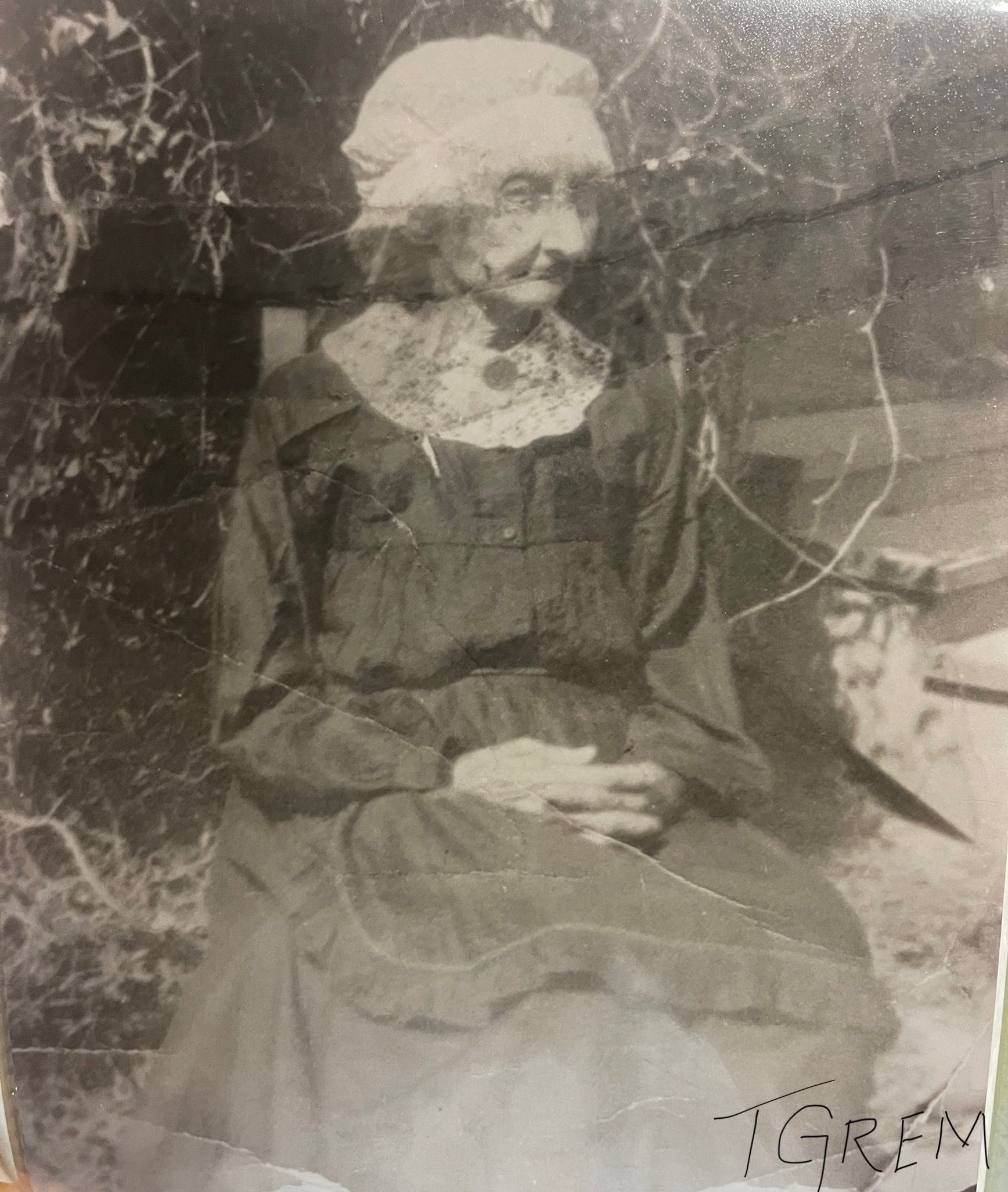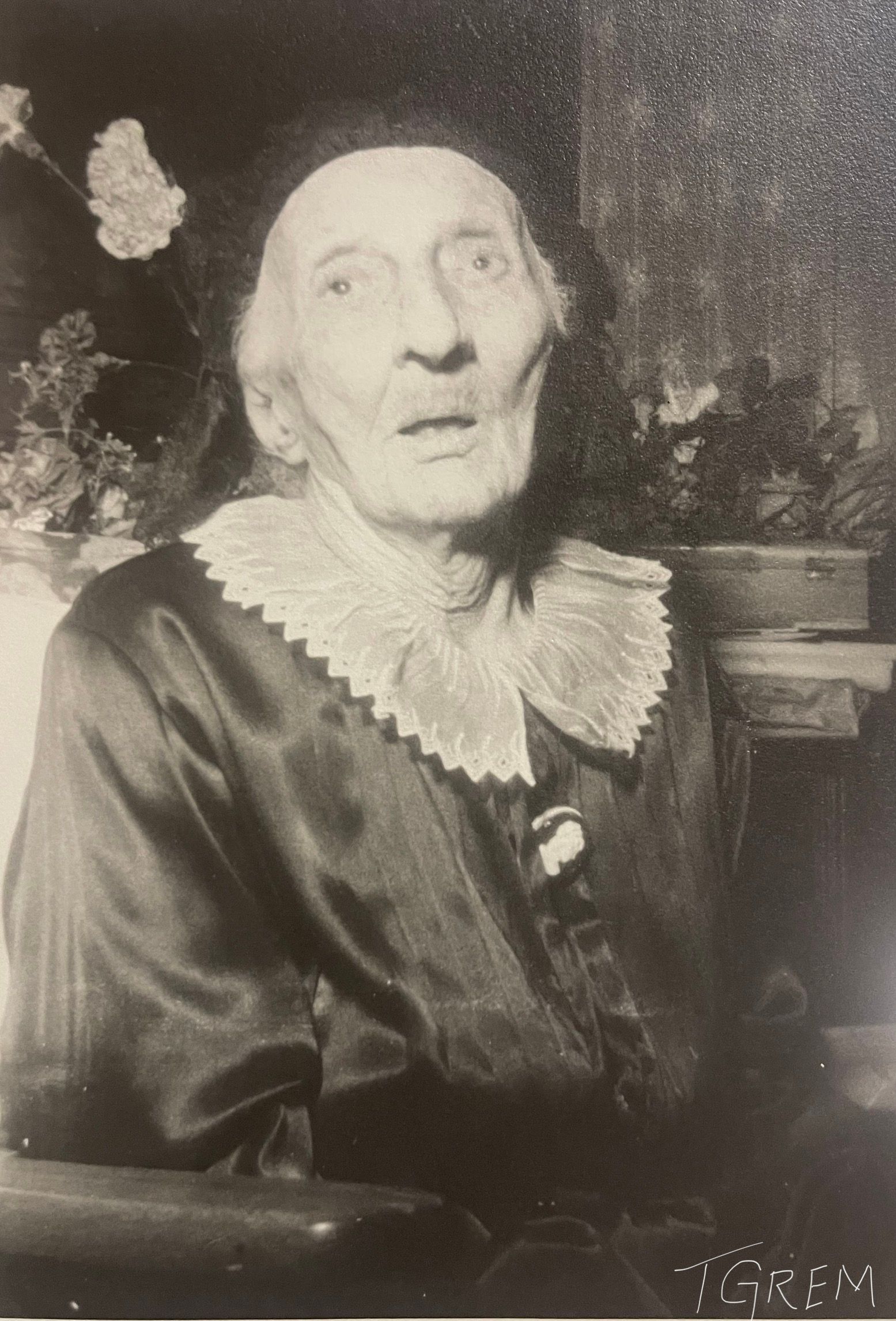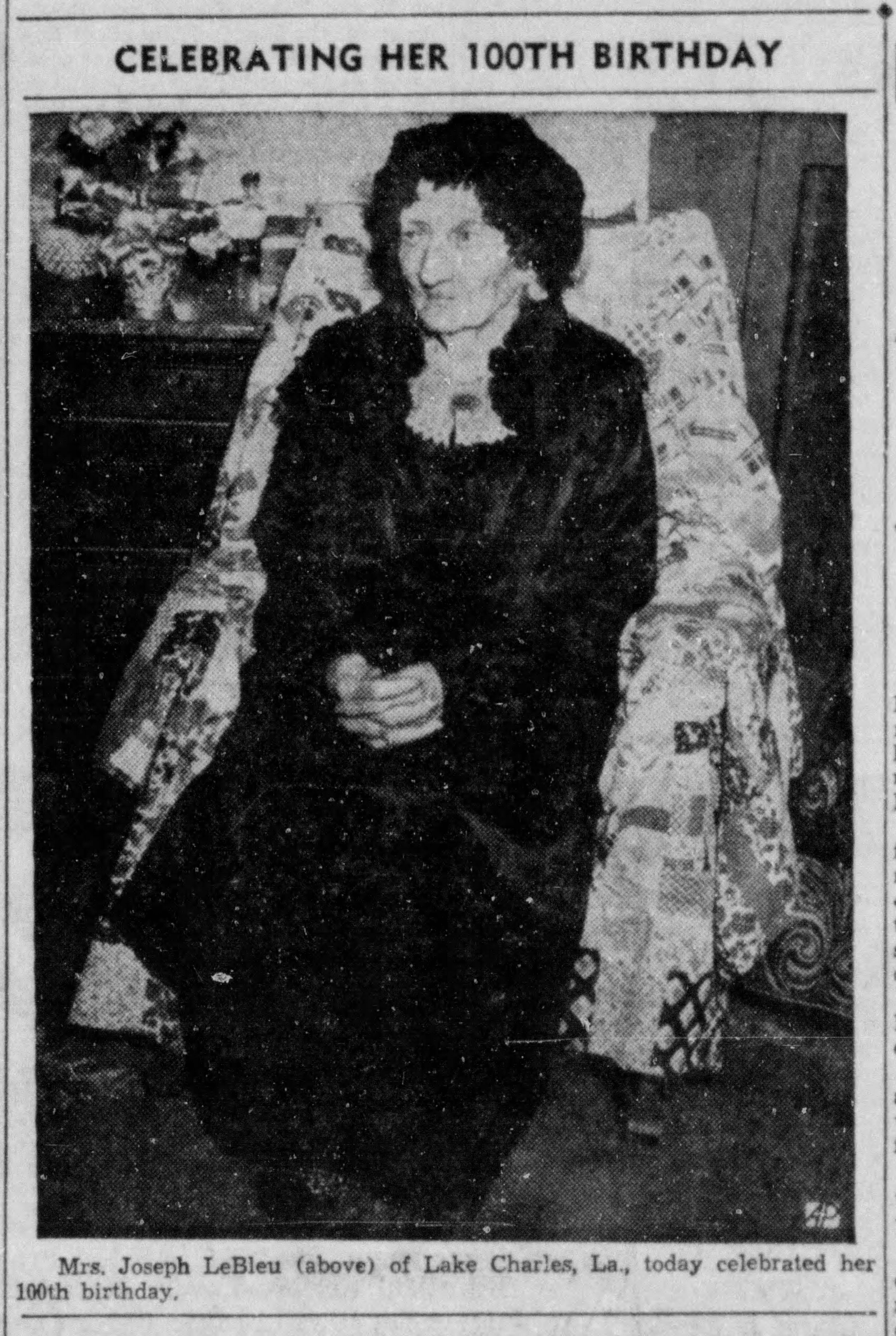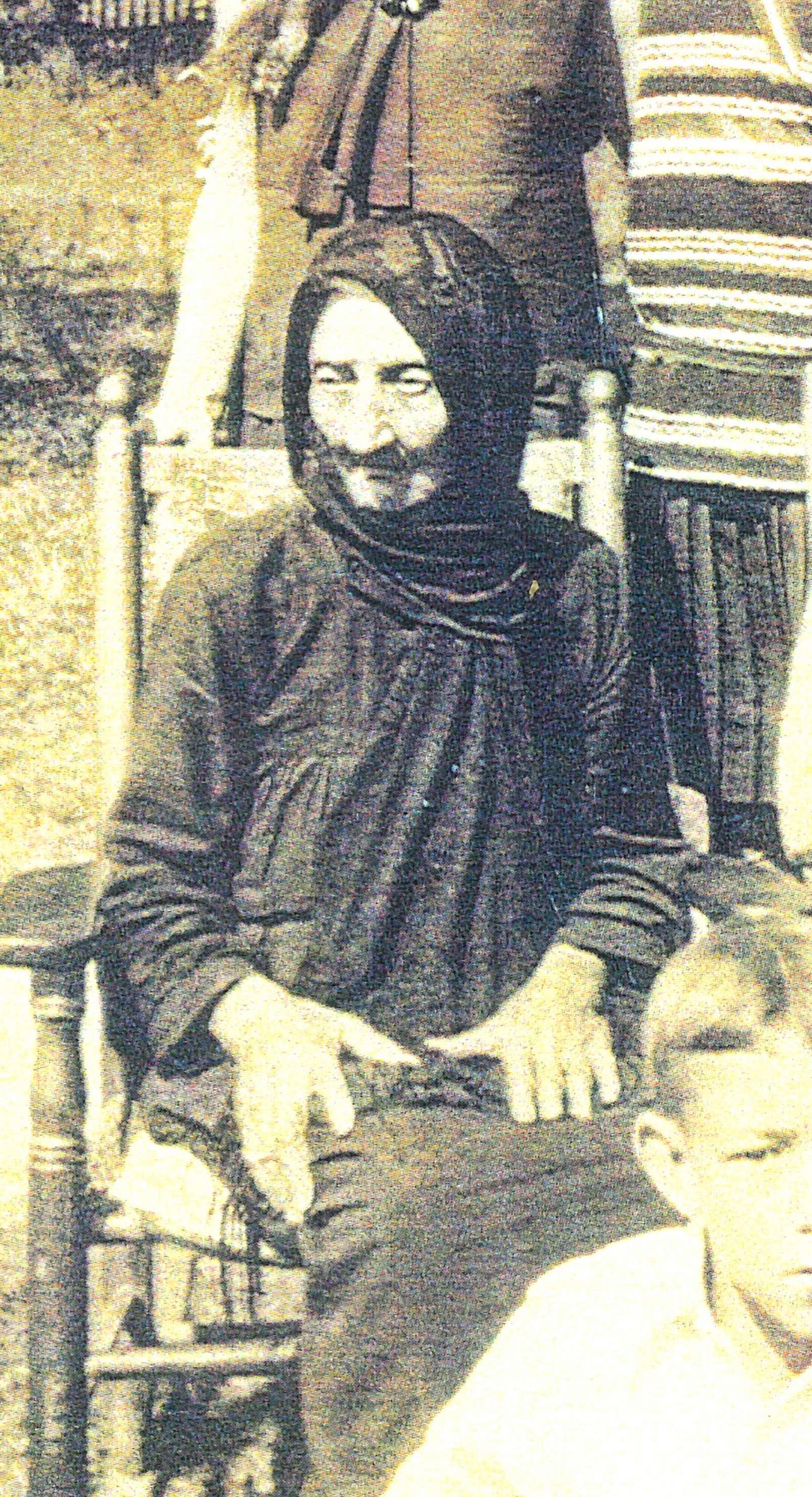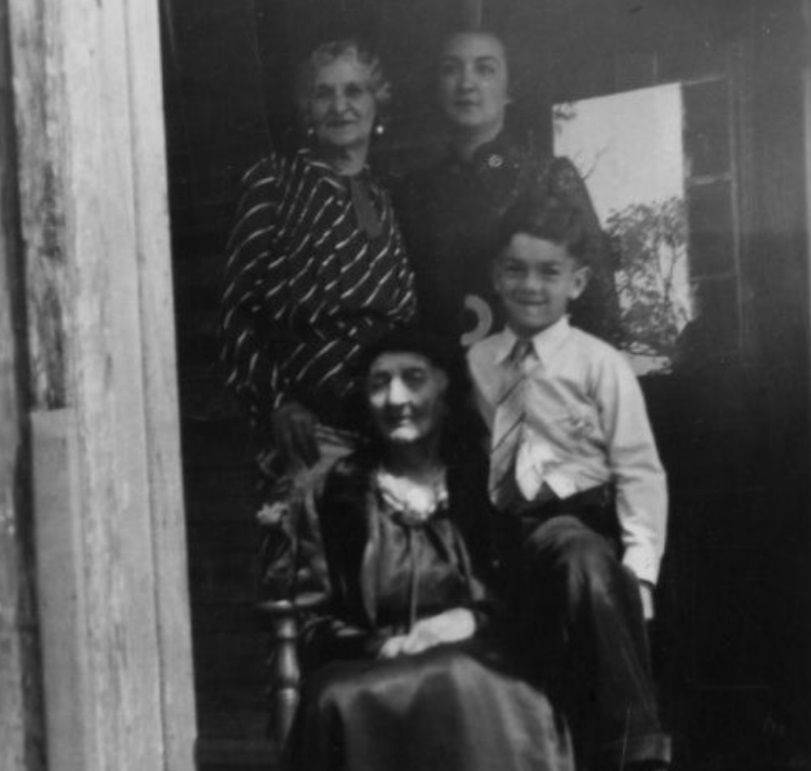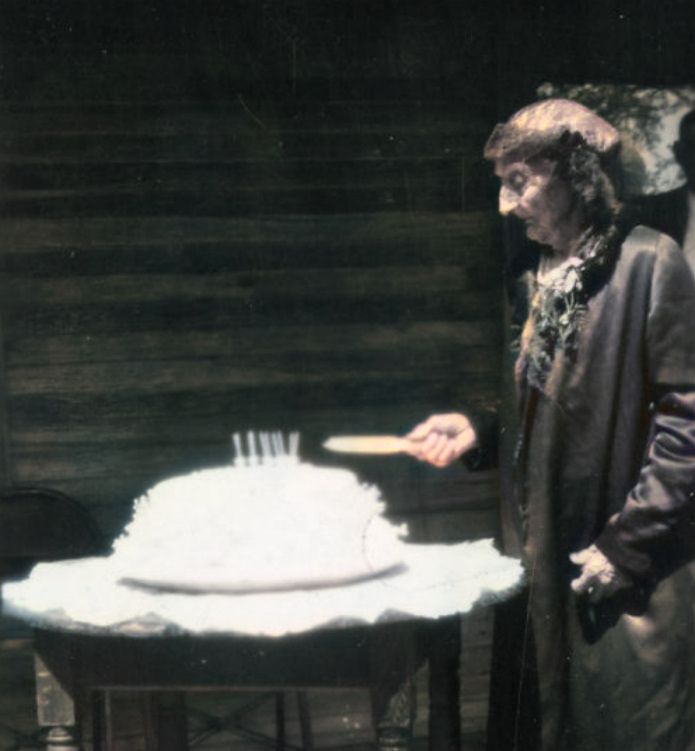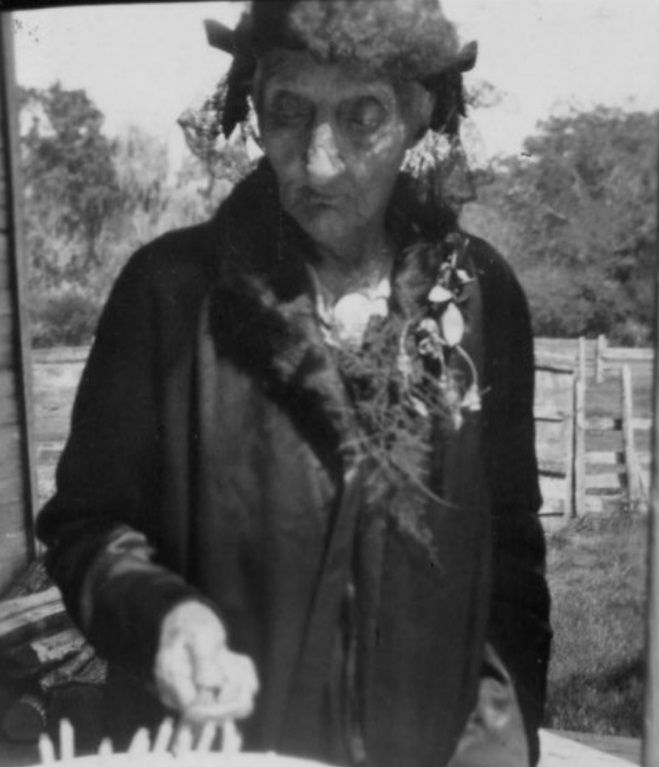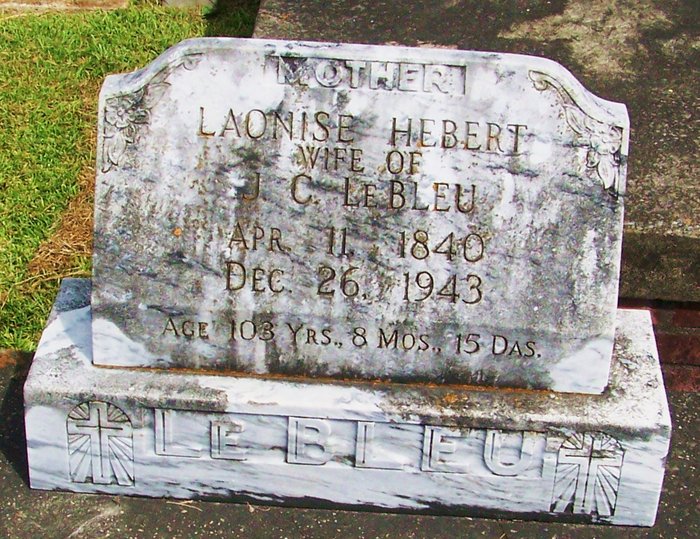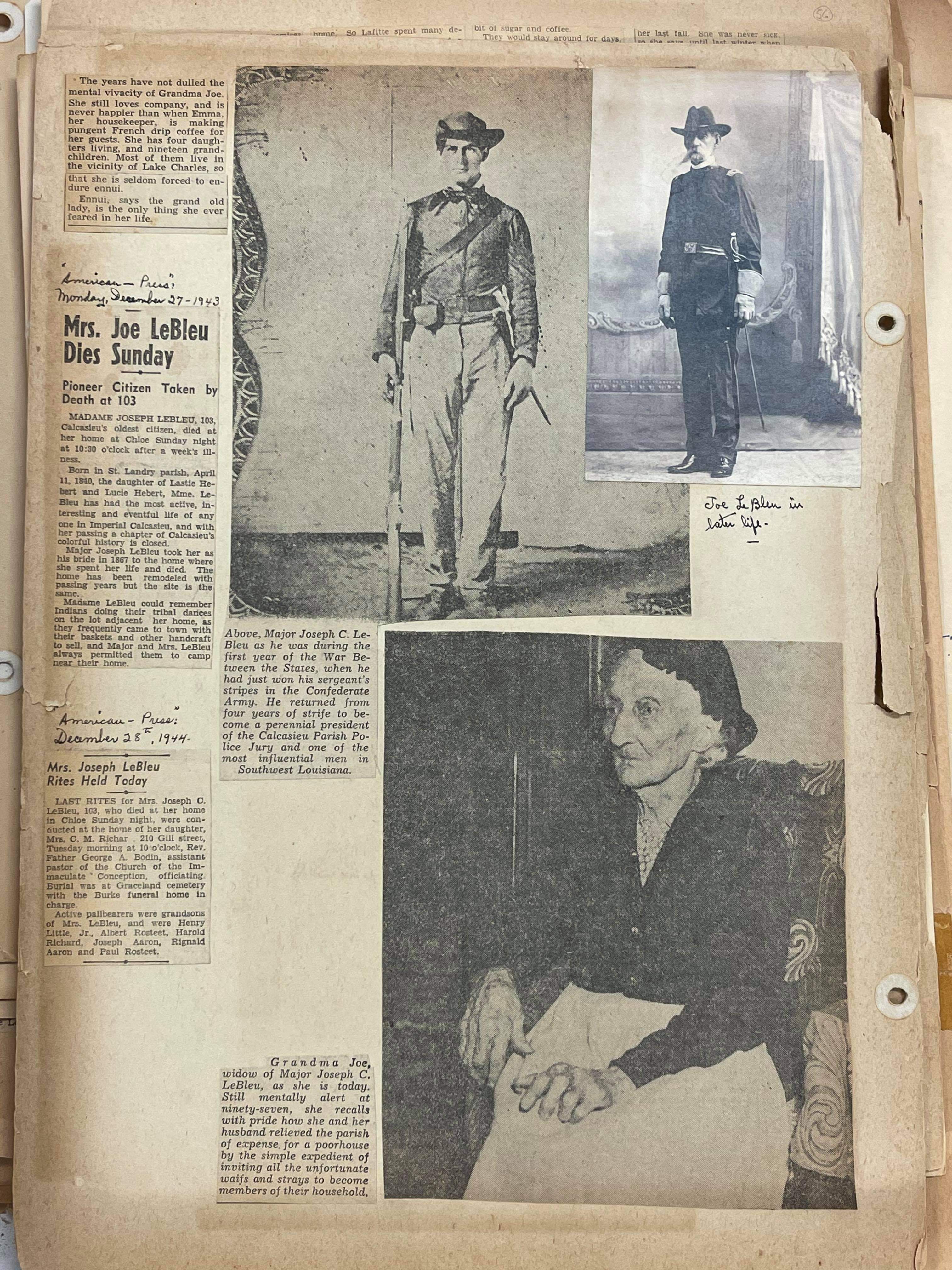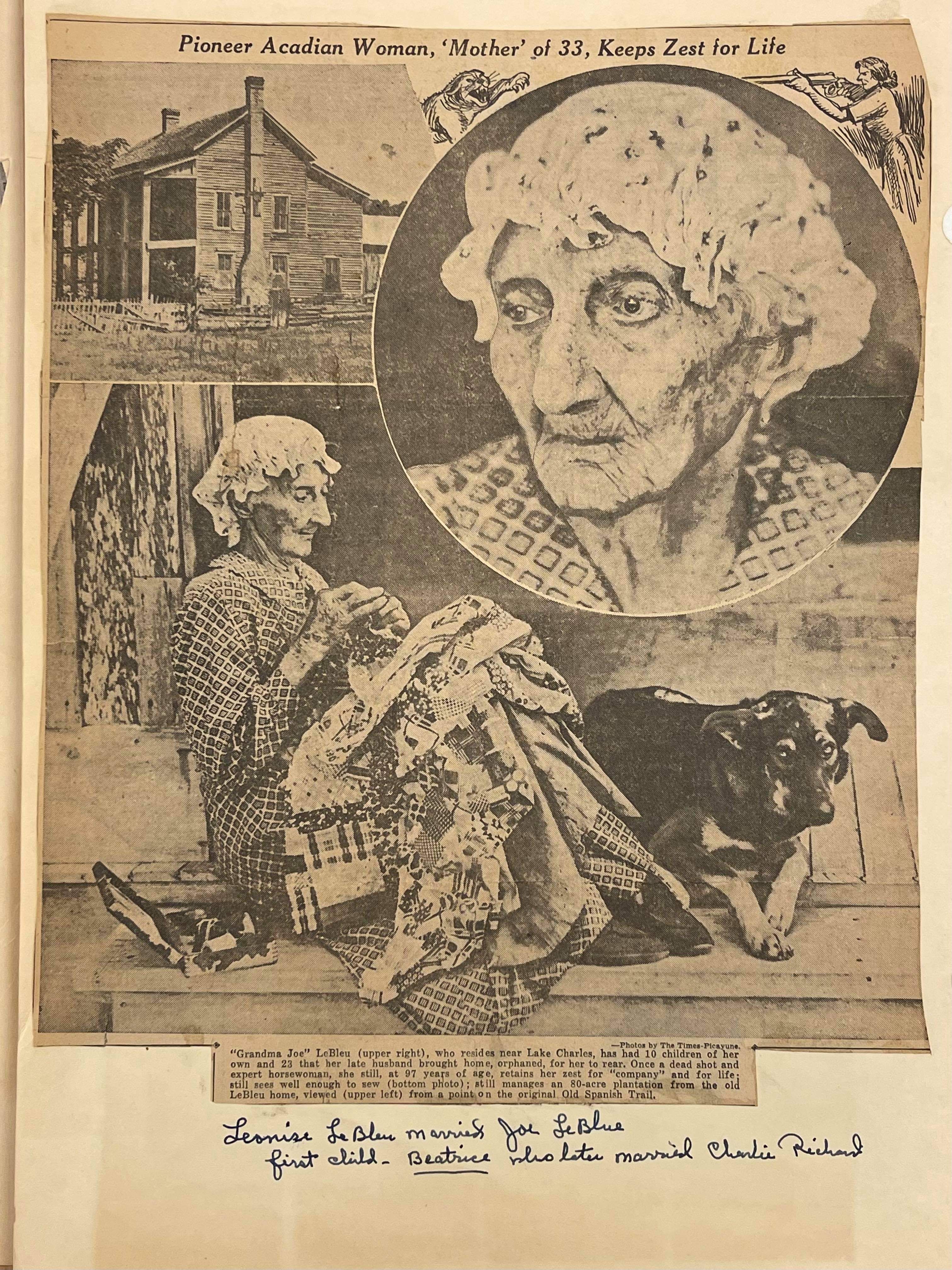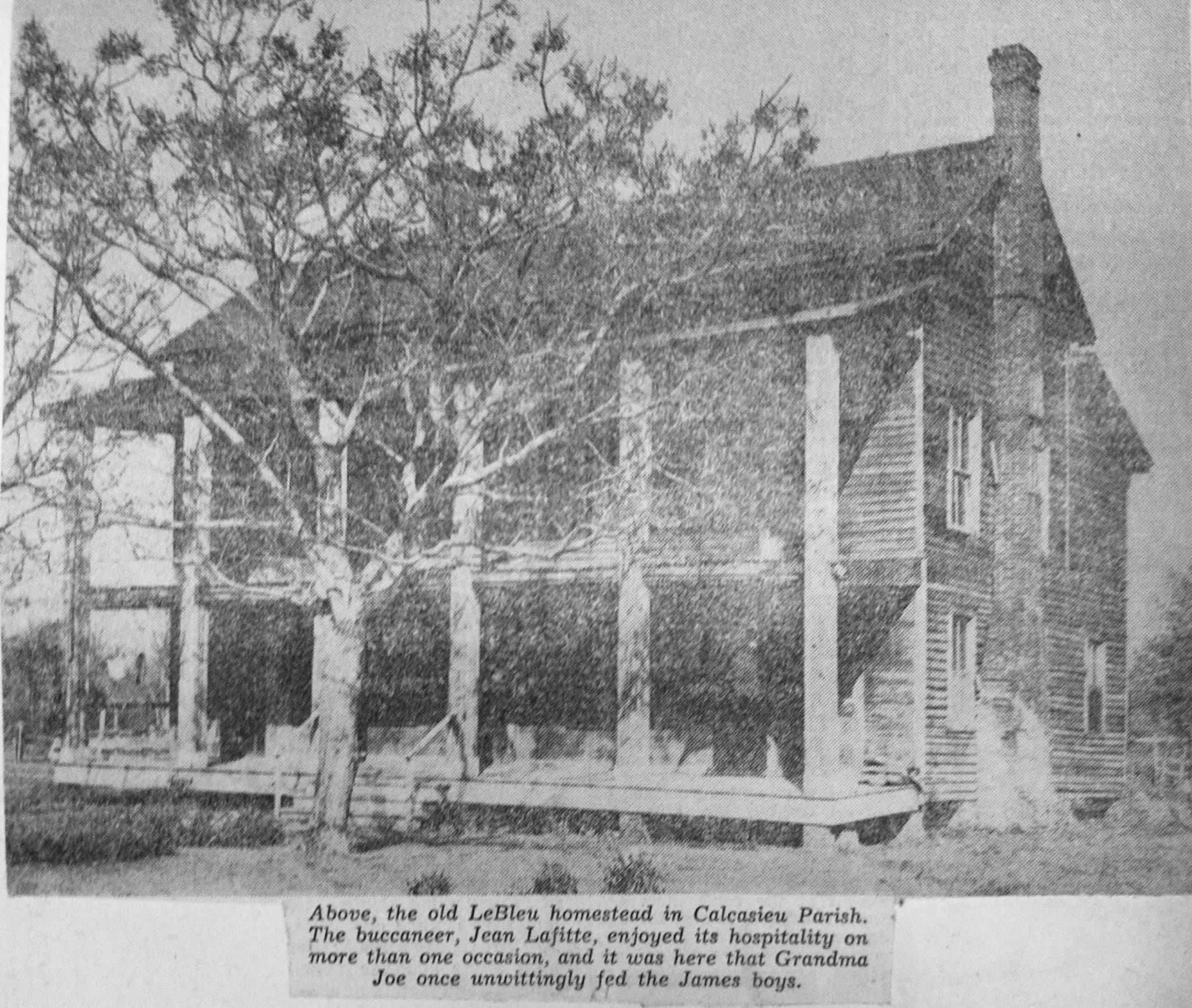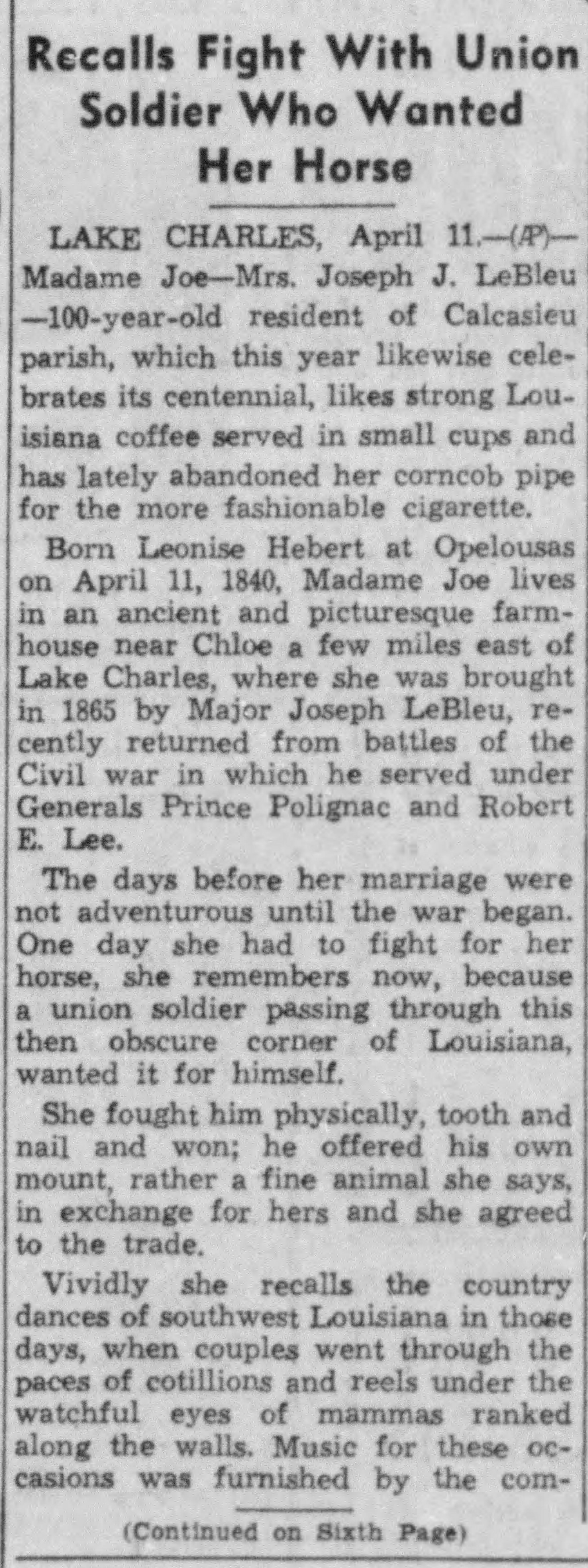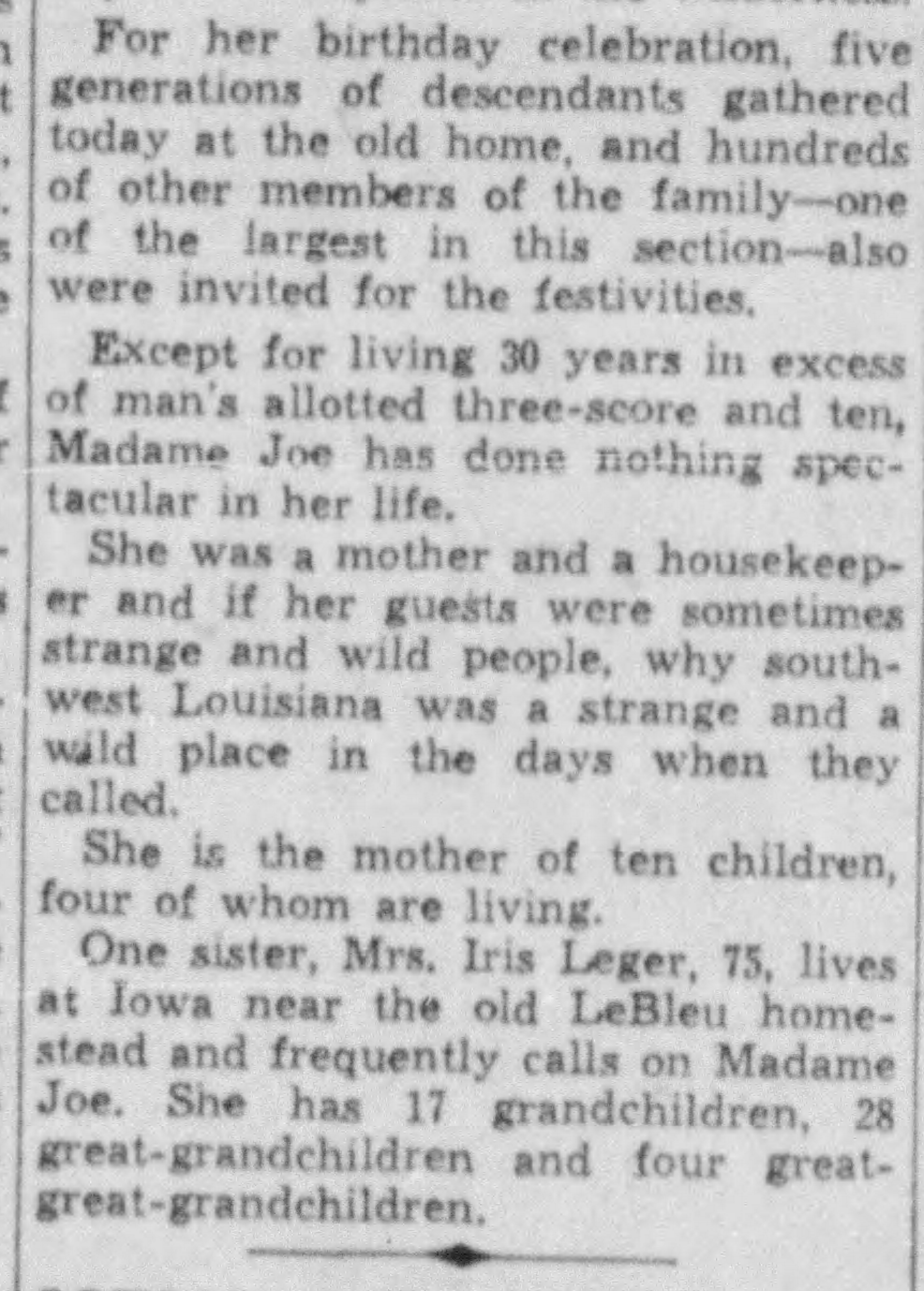Wife of J.C. LeBleu
Laonise LeBleu (58111461)
Suggested edit: Mrs. J. C. LeBleu Recalls Early Calcasieu
As Mrs. Joseph LeBleu, the oldest inhabitant of Calcasieu Parish, celebrates her one hundredth birthday anniversary today, the festival is one of statewide interest.
Assisting her will be five generations of her own family and many old friends who have known the LeBleus for generations, besides many others who will come from neighboring towns and states to join in the entertainment.
The picturesque old home, just a few miles east of here near Chloe, will present a gay air and open house will be kept all day so that the hostess may receive the congratulations and best wishes of her friends.
This little old lady who marks a century of useful, happy life, is still active. Her life has been spent at home, taking care of her husband and children, looking after others and making them happy.
Possessing a remarkable memory, Mrs. LeBIeu is able to give clear and accurate accounts of interesting events of early days. She remembers when the surrounding country was wild and unsettled, and visits from Indians were by no means uncommon. Her life is one chapter after another of fascinating stories that would fit beautifully into a romance of Southwest Louisiana.
Mrs. LeBleu was born near Opelousas, the daughter of Lastie and Lucy Augustin Hebert, on April 11, 1840. She was taken in infancy by her parents to the old Catholic church in Opelousas where she was christened Laonise, her parents acting as sponsors.
While Laonise was still a toddling child, her parents came to Calcasieu and settled near Hecker, where they lived for many years. In this picturesque and beautiful country, Laonise spent her happy childhood, receiving instruction in French at her mother's knee since there were no schools in rural Calcasieu at that time.
Dancing, horseback riding and other pastimes enjoyed by young people of that day gave Laonise pleasure and she became a remarkably fine horse woman. There was nothing she could not tame and ride and she had plenty of beautiful horses to select from as her father owned many head of livestock.
One day a detachment of Yankee soldiers were passing through the country. They stopped at her father's home for refreshment for men and beasts, which was never denied to strangers, and saw her favorite horse. The officer in command wanted the animal, and according to the custom of the times, decided he would take it.
Laonise thought differently about it and proceeded to put up a fierce fight for her favorite. She went into battle with the officer and emerged with torn garments, but victorious. The soldier declared that if his men could fight like that he would win all his battles.
He had a beautiful horse with him, valuable and superior to Laonise's steed, and this he gave her for her bravery and high spirit. But he insisted on taking her horse with him to which she finally consented.
Square dances were popular in those days and many a cotillion did Laonise Hebert dance to the music of the fiddles. She was petite, graceful, and a beautiful dancer, who never lacked for partners.
This was the gay, happy young girl with whom Major Joseph LeBleu fell in love at the close of the war, married and brought to his father's home as his bride.
Major LeBleu enlisted in the Confederate army at the age of 17 and served under Gen. Robert E. Lee in Virginia and under General Polignac in Louisiana. He was a participant in the battle of Mansfield and came through the war unscathed.
Laonise Hebert's father was a member of the home guard and she had two brothers Francois and Dorsalle Hebert, who served in the Confederate army.
After the close of the war Major LeBleu thought of settling down, so he asked the hand of Laonise Hebert in marriage and the wedding took place with great pomp and circumstance at the home of her parents. Weddings were festivals in those days, and this one was an event for the whole countryside
After the wedding they came to the same home where she now lives. It was the home of the major's parents, Mr. and Mm. Arsene LeBleu, among the largest land and slave holders in Southwest Louisiana.
The old home was a spacious cypress house covered with plaster, and plastered inside with attractive murals on the smooth walls. These remained until the coming of the saw mills, when the young wife decided she wanted planed boards on her walls, so they gave way to the march of progress and Laonise had her smooth, pretty walls.
|
|
|
Calcasieu Centenarian Likes Her Coffee Strong
Abandons Old Corncob Pipe for Modern Cigarette
Lake Charles, April 12, 1940. — Madame Joe — Mrs. Joseph LeBleu — 100-year-old resident of Calcasieu Parish which this year likewise celebrates its centennial, likes strong Louisiana coffee served in small cups and had lately abandoned her corncob pipe for the more fashionable cigarette.
Born Leonise Hebert at Opelousas on April 11. 1840, Madame Joe lives now in an ancient and picturesque farmhouse near Chloe a few miles east of Lake Charles, where she was brought in 1885 by Major Joseph Lebleu, recently returned from battles of the Civil War in which he served under Generals Prince Polignac and Robert E. Lee.
The days before her marriage were not adventurous until the war began. One day she had to fight for her horse, she remembers now, because a Union soldier passing through this then obscure corner of Louisiana, wanted it for himself.
She fought him physically, tooth and nail and won; he offered his our mount, rather a fine animal she says, in exchange for hers and she agreed to the trade.
Vividly she recalls the country dances of Southwest Louisiana in those days, when couples went through the paces of cotillions and reels under the watchful eyes of mammas ranked along the walls. Music for these occasions was furnished by the community fiddler who improvised new melodies, new songs as he played.
In her possession today she still has three pieces of furniture which were hers when she first came to live at the celebrated LeBleu home. A black walnut four-poster bed, a mahogany secretary and a huge old-fashioned sideboard which her husband's father had made to order a century ago.
Her home, which has been frequently remodeled and enlarged since Major LeBleu brought her there, was once a haven for Jean Lafitte who was a friend, local tradition says, of the LeBleu family.
Others callers at the home in early days included the James brothers and Indians.
Today, however, the curious from all parts of the nation call on Madame Joe to hear her tales in French or English of Southwest Louisiana's rough-and-tumble past when pirates and bandits were as good company as any other wayfarer in the wilderness.
For her birthday celebration five generations of descendants gathered yesterday at the old home, and hundreds of other members of the family — one of the largest in this section — also were invited for the festivities.
Except for living 30 years in excess of man's allotted threescore and ten, Madame Joe has done nothing spectacular in her life.
She was a mother and a housekeeper and if her guests were sometimes strange and wild people, why Southwest Louisiana was strange and a wild place in the days when they called.
She is the mother of ten children, four of whom are living.
One sister, Mrs. Iris Leger, 75, lives at Iowa near the old LeBleu homestead and frequently calls on Madame Joe. She has 17 grandchildren; 28 great-grandchildren and four great-great-grandchildren.
|
|
|
English Bayou Backs into Old LeBleu Home; Centenarian Stays On
(Lake Charles American Press, August 10, 1940)
Back water from English Bayou has entered the Chloe home of Mrs. Leonise LeBleu, Calcasieu's 100-year-old resident. Notwithstanding the four to five feet of flood water which covers the cook stove on the first floor, Mrs. LeBleu resolutely declines to leave her home, despite the urging of her children and grandchildren. She and her household attendants have moved to the second floor of her home, and there she expresses her determination to stay "for the duration."
|
|
|
Was it Lafitte's?
(Lake Charles American Press, September 22, 1933)
Was it Lafitte's? That is the question that is being asked by those who see the rusted rapier that was found on the banks of English bayou near the old LeBleu home at Chloe by L. Langley and brought to the American Press office by Henry Little. It is about three feet long, and looks as if it might have been hammered out by hand. It must have been a fierce looking weapon. It was found where it had apparently been washed out of the earth that had been removed from English Bayou when it was dredged some time ago.
|
|
|
From the scrapbook of Maude Reid: "I visited Mrs. LeBleu once in company with her daughter Beatrice (Mrs. C. M. Richard) when Mrs. LeBleu was in her late eighties - my first and only interview with her. A little below average height, slender, with a bright vivacious glint in her black eyes - almost bird-like, it was not difficult to imagine her as a young girl, full of the joy of life - and pretty. She still rolled - with a great skill - her own cigarettes which she handled in her gnarled old hands with a grace and verve that any Hollywood glamour girl might envy."
|
|
|
Area Rich in Legend
(Lake Charles American Press, December 14, 1935)
RICH IN legend, story and fact is the section of Southwest Louisiana through which the Old Spanish Trail passes. What with its stories of pirates, and gold, cattle drives and Indian occupation, few sections offer so colorful a background.
And as for beauty, its rivers and bayous, trees with over hanging moss furnishing a tapestry that can be matched nowhere else in other portions of South Louisiana and its flat prairies that give it a charm all its own, it is indeed a land to which many visitors are drawn each year.
Entering this territory of the Old Spanish Trail, once all a part of Old Imperial Calcasieu (a parish originally that was bigger than Rhode Island and nearly as large as the state of Delaware) at the Mermentau River on the east, the traveler is immediately impressed with the wide expanse of prairie land, stretching as far as the eye can see.
First on the route coming from the east into this section is the city of Jennings, which celebrated its 50th anniversary last fall. Settled by men from Iowa and other Middle Western states, the city, with its beautiful trees, where was once bald prairie, is a northern town in a French, Southern area.
Traveling from Iowa, on the same trail as that which the earliest settlers once traveled, and on over which the pony express used to bring mail to Lake Charles from Lafayette, the voyager passes in front of the old LeBleu home, just south of Chloe, the site of which Jean Lafitte made his headquarters when in this sections.
This home occupied by its owner, the gracious Mrs. J. C. LeBleu, still active in spite of her 97 years, is just six miles east of Lake Charles, the largest city in Southwest Louisiana, situated on beautiful and historic Lake Charles. — E. W. Stagg.
|
|
|
Lake Charles American Press, July 26, 1943 — Last Slave of LeBleu's Died Saturday — James Alphonse, 94, last slave of the late Major J. C. LeBleu died Saturday evening and was buried Sunday in the negro cemetery at Chloe. Alphonse had lived for many years with his sister, Georgia Anderson, at Chloe in whose home he died. He has five children living and could count four generations succeeding himself. (Source: Trent Gremillion)
Contributor: Trent Gremillion (48319447) • [email protected]
Wife of J.C. LeBleu
Laonise LeBleu (58111461)
Suggested edit: Mrs. J. C. LeBleu Recalls Early Calcasieu
As Mrs. Joseph LeBleu, the oldest inhabitant of Calcasieu Parish, celebrates her one hundredth birthday anniversary today, the festival is one of statewide interest.
Assisting her will be five generations of her own family and many old friends who have known the LeBleus for generations, besides many others who will come from neighboring towns and states to join in the entertainment.
The picturesque old home, just a few miles east of here near Chloe, will present a gay air and open house will be kept all day so that the hostess may receive the congratulations and best wishes of her friends.
This little old lady who marks a century of useful, happy life, is still active. Her life has been spent at home, taking care of her husband and children, looking after others and making them happy.
Possessing a remarkable memory, Mrs. LeBIeu is able to give clear and accurate accounts of interesting events of early days. She remembers when the surrounding country was wild and unsettled, and visits from Indians were by no means uncommon. Her life is one chapter after another of fascinating stories that would fit beautifully into a romance of Southwest Louisiana.
Mrs. LeBleu was born near Opelousas, the daughter of Lastie and Lucy Augustin Hebert, on April 11, 1840. She was taken in infancy by her parents to the old Catholic church in Opelousas where she was christened Laonise, her parents acting as sponsors.
While Laonise was still a toddling child, her parents came to Calcasieu and settled near Hecker, where they lived for many years. In this picturesque and beautiful country, Laonise spent her happy childhood, receiving instruction in French at her mother's knee since there were no schools in rural Calcasieu at that time.
Dancing, horseback riding and other pastimes enjoyed by young people of that day gave Laonise pleasure and she became a remarkably fine horse woman. There was nothing she could not tame and ride and she had plenty of beautiful horses to select from as her father owned many head of livestock.
One day a detachment of Yankee soldiers were passing through the country. They stopped at her father's home for refreshment for men and beasts, which was never denied to strangers, and saw her favorite horse. The officer in command wanted the animal, and according to the custom of the times, decided he would take it.
Laonise thought differently about it and proceeded to put up a fierce fight for her favorite. She went into battle with the officer and emerged with torn garments, but victorious. The soldier declared that if his men could fight like that he would win all his battles.
He had a beautiful horse with him, valuable and superior to Laonise's steed, and this he gave her for her bravery and high spirit. But he insisted on taking her horse with him to which she finally consented.
Square dances were popular in those days and many a cotillion did Laonise Hebert dance to the music of the fiddles. She was petite, graceful, and a beautiful dancer, who never lacked for partners.
This was the gay, happy young girl with whom Major Joseph LeBleu fell in love at the close of the war, married and brought to his father's home as his bride.
Major LeBleu enlisted in the Confederate army at the age of 17 and served under Gen. Robert E. Lee in Virginia and under General Polignac in Louisiana. He was a participant in the battle of Mansfield and came through the war unscathed.
Laonise Hebert's father was a member of the home guard and she had two brothers Francois and Dorsalle Hebert, who served in the Confederate army.
After the close of the war Major LeBleu thought of settling down, so he asked the hand of Laonise Hebert in marriage and the wedding took place with great pomp and circumstance at the home of her parents. Weddings were festivals in those days, and this one was an event for the whole countryside
After the wedding they came to the same home where she now lives. It was the home of the major's parents, Mr. and Mm. Arsene LeBleu, among the largest land and slave holders in Southwest Louisiana.
The old home was a spacious cypress house covered with plaster, and plastered inside with attractive murals on the smooth walls. These remained until the coming of the saw mills, when the young wife decided she wanted planed boards on her walls, so they gave way to the march of progress and Laonise had her smooth, pretty walls.
|
|
|
Calcasieu Centenarian Likes Her Coffee Strong
Abandons Old Corncob Pipe for Modern Cigarette
Lake Charles, April 12, 1940. — Madame Joe — Mrs. Joseph LeBleu — 100-year-old resident of Calcasieu Parish which this year likewise celebrates its centennial, likes strong Louisiana coffee served in small cups and had lately abandoned her corncob pipe for the more fashionable cigarette.
Born Leonise Hebert at Opelousas on April 11. 1840, Madame Joe lives now in an ancient and picturesque farmhouse near Chloe a few miles east of Lake Charles, where she was brought in 1885 by Major Joseph Lebleu, recently returned from battles of the Civil War in which he served under Generals Prince Polignac and Robert E. Lee.
The days before her marriage were not adventurous until the war began. One day she had to fight for her horse, she remembers now, because a Union soldier passing through this then obscure corner of Louisiana, wanted it for himself.
She fought him physically, tooth and nail and won; he offered his our mount, rather a fine animal she says, in exchange for hers and she agreed to the trade.
Vividly she recalls the country dances of Southwest Louisiana in those days, when couples went through the paces of cotillions and reels under the watchful eyes of mammas ranked along the walls. Music for these occasions was furnished by the community fiddler who improvised new melodies, new songs as he played.
In her possession today she still has three pieces of furniture which were hers when she first came to live at the celebrated LeBleu home. A black walnut four-poster bed, a mahogany secretary and a huge old-fashioned sideboard which her husband's father had made to order a century ago.
Her home, which has been frequently remodeled and enlarged since Major LeBleu brought her there, was once a haven for Jean Lafitte who was a friend, local tradition says, of the LeBleu family.
Others callers at the home in early days included the James brothers and Indians.
Today, however, the curious from all parts of the nation call on Madame Joe to hear her tales in French or English of Southwest Louisiana's rough-and-tumble past when pirates and bandits were as good company as any other wayfarer in the wilderness.
For her birthday celebration five generations of descendants gathered yesterday at the old home, and hundreds of other members of the family — one of the largest in this section — also were invited for the festivities.
Except for living 30 years in excess of man's allotted threescore and ten, Madame Joe has done nothing spectacular in her life.
She was a mother and a housekeeper and if her guests were sometimes strange and wild people, why Southwest Louisiana was strange and a wild place in the days when they called.
She is the mother of ten children, four of whom are living.
One sister, Mrs. Iris Leger, 75, lives at Iowa near the old LeBleu homestead and frequently calls on Madame Joe. She has 17 grandchildren; 28 great-grandchildren and four great-great-grandchildren.
|
|
|
English Bayou Backs into Old LeBleu Home; Centenarian Stays On
(Lake Charles American Press, August 10, 1940)
Back water from English Bayou has entered the Chloe home of Mrs. Leonise LeBleu, Calcasieu's 100-year-old resident. Notwithstanding the four to five feet of flood water which covers the cook stove on the first floor, Mrs. LeBleu resolutely declines to leave her home, despite the urging of her children and grandchildren. She and her household attendants have moved to the second floor of her home, and there she expresses her determination to stay "for the duration."
|
|
|
Was it Lafitte's?
(Lake Charles American Press, September 22, 1933)
Was it Lafitte's? That is the question that is being asked by those who see the rusted rapier that was found on the banks of English bayou near the old LeBleu home at Chloe by L. Langley and brought to the American Press office by Henry Little. It is about three feet long, and looks as if it might have been hammered out by hand. It must have been a fierce looking weapon. It was found where it had apparently been washed out of the earth that had been removed from English Bayou when it was dredged some time ago.
|
|
|
From the scrapbook of Maude Reid: "I visited Mrs. LeBleu once in company with her daughter Beatrice (Mrs. C. M. Richard) when Mrs. LeBleu was in her late eighties - my first and only interview with her. A little below average height, slender, with a bright vivacious glint in her black eyes - almost bird-like, it was not difficult to imagine her as a young girl, full of the joy of life - and pretty. She still rolled - with a great skill - her own cigarettes which she handled in her gnarled old hands with a grace and verve that any Hollywood glamour girl might envy."
|
|
|
Area Rich in Legend
(Lake Charles American Press, December 14, 1935)
RICH IN legend, story and fact is the section of Southwest Louisiana through which the Old Spanish Trail passes. What with its stories of pirates, and gold, cattle drives and Indian occupation, few sections offer so colorful a background.
And as for beauty, its rivers and bayous, trees with over hanging moss furnishing a tapestry that can be matched nowhere else in other portions of South Louisiana and its flat prairies that give it a charm all its own, it is indeed a land to which many visitors are drawn each year.
Entering this territory of the Old Spanish Trail, once all a part of Old Imperial Calcasieu (a parish originally that was bigger than Rhode Island and nearly as large as the state of Delaware) at the Mermentau River on the east, the traveler is immediately impressed with the wide expanse of prairie land, stretching as far as the eye can see.
First on the route coming from the east into this section is the city of Jennings, which celebrated its 50th anniversary last fall. Settled by men from Iowa and other Middle Western states, the city, with its beautiful trees, where was once bald prairie, is a northern town in a French, Southern area.
Traveling from Iowa, on the same trail as that which the earliest settlers once traveled, and on over which the pony express used to bring mail to Lake Charles from Lafayette, the voyager passes in front of the old LeBleu home, just south of Chloe, the site of which Jean Lafitte made his headquarters when in this sections.
This home occupied by its owner, the gracious Mrs. J. C. LeBleu, still active in spite of her 97 years, is just six miles east of Lake Charles, the largest city in Southwest Louisiana, situated on beautiful and historic Lake Charles. — E. W. Stagg.
|
|
|
Lake Charles American Press, July 26, 1943 — Last Slave of LeBleu's Died Saturday — James Alphonse, 94, last slave of the late Major J. C. LeBleu died Saturday evening and was buried Sunday in the negro cemetery at Chloe. Alphonse had lived for many years with his sister, Georgia Anderson, at Chloe in whose home he died. He has five children living and could count four generations succeeding himself. (Source: Trent Gremillion)
Contributor: Trent Gremillion (48319447) • [email protected]
